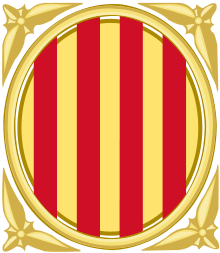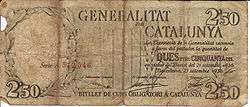Catalan Republic
| Catalan Republic / Catalan State | |||||
| República Catalana / Estat Català | |||||
| |||||
 Emblem (1934)
| |||||
| Anthem Els Segadors (Catalan)[1] "The Reapers" | |||||
 Map of Europe with the Catalan Republic (c. 1641) by Willem Blaeu. | |||||
| Capital | Barcelona | ||||
| Languages | Catalan | ||||
| Government | Republic | ||||
| President | |||||
| • | 1641 | Pau Claris i Casademunt | |||
| • | 1873 | Baldomer Lostau i Prats | |||
| • | 1931 | Francesc Macià i Llussà | |||
| • | 1934 | Lluís Companys i Jover | |||
| Legislature | General Estates (1641) Parliament (1934) | ||||
| History | |||||
| • | Proclaimed (most recently) | October 6, 1934 | |||
| • | Disestablished (most recently) | October 7, 1934 | |||
| Today part of | ∟ | ||||
The Catalan Republic (Catalan: República Catalana, IPA: [rəˈpubːlikə kətəˈlanə]) is one of the terms adopted by Catalonia when it declares itself as a sovereign political subject. The constitution of a Catalan State is currently the aim of a broad-based grassroots movement for Catalan independence.
A Catalan Republic, also known as the Catalan State (Estat Català, IPA: [əsˈtat kətəˈla]), has so far been proclaimed four times:
- In 1641, by Pau Claris.
- In 1873, by Baldomer Lostau[2] as the "Catalan State".
- In 1931, by Francesc Macià as the "Catalan Republic within the Iberian Federation".[3]
- In 1934, by Lluís Companys as the "Catalan State within the Spanish Federal Republic".
Of these four proclamations, the first (1641) was performed with the objective to establish the complete independence and the rest (1873, 1931 and 1934) to establish the sovereignty and the state character of Catalonia inside an Iberian or Spanish Federal Republic.
In November 2015, the Catalan parliament adopted a declaration of intent to form a new independent republic no later than 2017.[4]
Junctures of independence or segregation from Spain or France
- 988: The count of Barcelona Borrell II denies the vassalage of the Catalan counties to the French king Hugh Capet.[5]
- 1641: The General Estates ("Braços Generals") presided by the head of the Deputation of the General of Catalonia Pau Claris, proclaimed the Catalan Republic on January 17.
- 1641-1652: On January 23, 1641, the "Braços Generals" presided by Pau Claris proclaimed Louis XIII of France as count of Barcelona, putting the Principality of Catalonia under French sovereignty. When Louis XIII died, in 1643, Louis XIV (the Sun King) relieved him until 1652, when it was reincorporated in the Spanish Monarchy.
- 1712: Proposal of creation of a Catalan Republic under the protection of the United Kingdom.[6]
- 1793: During the War of the Pyrenees between Spain and the First French Republic, some French leaders proposed the creation of a Catalan Republic twinned with France, as the other Sister Republics created with the breakthrough of the French revolutionary army.[7]
- 1810-1812: Napoleon I makes Catalonia independent under French control.
- 1812-1814: Catalonia is annexed to France by Napoleon.
- 1873: The Catalan State is proclaimed by the Provincial Deputation of Barcelona.[8]
- 14–17 April 1931: Francesc Macià proclaims the Catalan Republic as state inside the Iberian Federation.
- 6 October 1934: The President of the Generalitat of Catalonia, Lluís Companys, proclaims the Catalan State of the Spanish Federal Republic.
Proclamation of 1641

During the Catalan Revolt started in 1640, on 17 January 1641, Pau Claris, president of the Deputation of the General (or Generalitat) of Catalonia proclaimed, according with the General Estates of Catalonia, the Catalan Republic under French protection for the first time. A week later, following the intervention of Philip IV of Spain, who entered in Catalonia with his army in order to suppress the revolt, Pau Claris appealed on 23 January to Louis XIII of France and recognized him as Count of Barcelona (the title having been transmitted to his heir Louis XIV until 1652) and places the Principality of Catalonia under French sovereignty.
On January 26, 1641, at the end of the battle of Montjuïc, the army of Philip IV was defeated and had to withdraw. Pau Claris died a month later. Finally, the dismissal of the Count-Duke of Olivares, the ravages caused by the famine and the plague, as well as the commitment taken by Philip IV to respect the Catalan constitutions and institutions, put an end to the war in 1652, and the Principality of Catalonia was reincorporated to the Monarchy of Spain.[9]
Pact of Tortosa and proclamation of 1873
On 18 May 1869 the representatives of the federal-republican committees of Aragon, Catalonia, Valencia and the Balearic Islands signed the Federal Pact of Tortosa to work together in order to establish the Spanish Federal Republic, making it clear that they defend the unity of Spain.[10]
Two years later, during the First Spanish Republic, the proclamation of the Catalan State within the Spanish Federal Republic took place in Barcelona on 9 March 1873. It was proclaimed by the Provincial Deputation of Barcelona, which elected the republican federalist Baldomer Lostau i Prats as the provisional president of the State. After the president of the First Spanish Republic, Estanislau Figueras, and the head of the federal party, Francesc Pi i Maragall, promised the dissolution of the Spanish army in Catalonia, the proclamation was revoked.
Proclamation of 1931
By the Pact of San Sebastián (August 17, 1930), the Spanish republican parties agree to prepare a change of regime in case of victories in the following elections. In this project, there was a provision for the political autonomy of Catalonia, within the Republic. On 14 April 1931, after the municipal elections which gave in Catalonia the large majority to a party founded three weeks before of the elections by the union of the independentist Estat Català and the Catalan Republican Party, the Republican Left of Catalonia (ERC), its leader Francesc Macià, few hours before the proclamation of the Second Spanish Republic in Madrid, from the balcony of the Palace of the Generalitat (then the seat of the Provincial Deputation of Barcelona), proclaimed the "Catalan Republic, expecting that the other peoples of Spain constitute themselves as republics, in order to establish the Iberian Confederation". Macià was appointed as acting president.
Three days later, the government of new the Spanish Republic, worried, sent three ministers (Fernando de los Ríos, Lluís Nicolau d'Olwer and Marcel·lí Domingo) to Barcelona to negotiate with Macià and the Catalan government. Macià reached an agreement with the ministers, in which the Catalan Republic was renamed Generalitat of Catalonia, becoming an autonomous government inside the Spanish Republic, that will be granted an Statute of Autonomy after the elections to Spanish Cortes. Francesc Macià will be the President of the Generalitat of Catalonia until his death in 1933.
Proclamation of 1934

On 6 October 1934, the President of the Generalitat, Lluís Companys (ERC), proclaimed again the Catalan State within the Spanish Federal Republic. The event was part of a semi-insurrectional program of the left against the new Spanish right-wing republican government led by Alejandro Lerroux, which incorporated as ministers some members of the CEDA, Spanish political party that was considered close to fascism and, therefore, they feared that it was the first step of this party to take the power as Hitler and Dollfuss made in Germany and Austria.
The attempt was quickly aborted by the Spanish government, the general Domènec Batet, chief of the IV Organic Division in Catalonia, crushed the uprising.[11] Companys was arrested and imprisoned; the autonomous government suspended, and virtually all its members jailed. After the Popular Front victory in the February 1936 Spanish general election, his government was pardoned and reinstated in their functions.
Gallery
 Bank note from the Generalitat de Catalunya, 1936.
Bank note from the Generalitat de Catalunya, 1936.
See also
- Catalonia
- Catalan independence
- Tortosa Pact
- Declaration of the Initiation of the Process of Independence of Catalonia
- List of shortest-lived sovereign states
References
- ↑ Used as de facto national anthem during the last two proclamations.
- ↑ Biografía de Estanislao Figueras y Moragas en Biografías y Vidas
- ↑ Spain: Macià's Catalonia, Time, Jun 20, 1932.
- ↑ Joseph Wilson (2015-11-09). "Catalan lawmakers approve plan for secession from Spain". Associated Press. Retrieved 2015-11-09.
- ↑ Borrell II de Barcelona, enciclopèdia.cat, 04-09-2013
- ↑ Catalans' Case, enciclopèdia.cat, 03-01-2014
- ↑ Coll i Alentorn, Miquel. Història, ed. L'Abadia de Montserrat, 1992, vol. 2
- ↑ Duràn i Solà, Lluís. Breu història del catalanisme, ed. L'Abadia de Montserrat, 2009 vol.1, page 19, ISBN 8498831741
- ↑ Florensa i Soler, Núria. La declinación de la monarquía hispánica en el siglo XVII. Univ. de Castilla La Mancha, 2004 ISBN 8484272966
- ↑ Almirall, Valentí: España tal com és
- ↑ Finestres & López 2014, p. 31-32.

